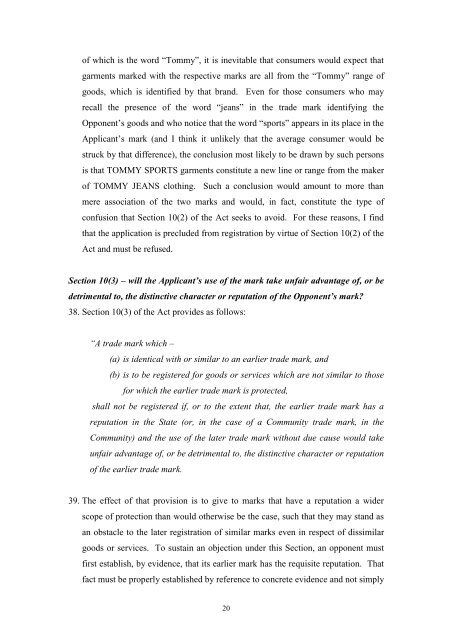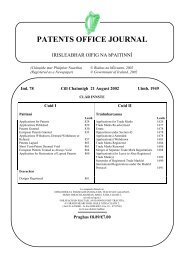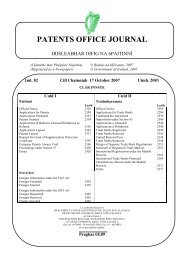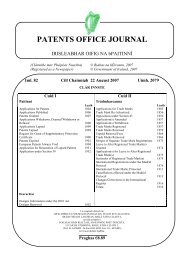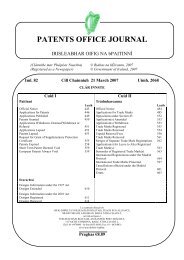TRADE MARKS ACT, 1963 - Irish Patents Office
TRADE MARKS ACT, 1963 - Irish Patents Office
TRADE MARKS ACT, 1963 - Irish Patents Office
Create successful ePaper yourself
Turn your PDF publications into a flip-book with our unique Google optimized e-Paper software.
of which is the word “Tommy”, it is inevitable that consumers would expect that<br />
garments marked with the respective marks are all from the “Tommy” range of<br />
goods, which is identified by that brand. Even for those consumers who may<br />
recall the presence of the word “jeans” in the trade mark identifying the<br />
Opponent’s goods and who notice that the word “sports” appears in its place in the<br />
Applicant’s mark (and I think it unlikely that the average consumer would be<br />
struck by that difference), the conclusion most likely to be drawn by such persons<br />
is that TOMMY SPORTS garments constitute a new line or range from the maker<br />
of TOMMY JEANS clothing. Such a conclusion would amount to more than<br />
mere association of the two marks and would, in fact, constitute the type of<br />
confusion that Section 10(2) of the Act seeks to avoid. For these reasons, I find<br />
that the application is precluded from registration by virtue of Section 10(2) of the<br />
Act and must be refused.<br />
Section 10(3) – will the Applicant’s use of the mark take unfair advantage of, or be<br />
detrimental to, the distinctive character or reputation of the Opponent’s mark?<br />
38. Section 10(3) of the Act provides as follows:<br />
“A trade mark which –<br />
(a) is identical with or similar to an earlier trade mark, and<br />
(b) is to be registered for goods or services which are not similar to those<br />
for which the earlier trade mark is protected,<br />
shall not be registered if, or to the extent that, the earlier trade mark has a<br />
reputation in the State (or, in the case of a Community trade mark, in the<br />
Community) and the use of the later trade mark without due cause would take<br />
unfair advantage of, or be detrimental to, the distinctive character or reputation<br />
of the earlier trade mark.<br />
39. The effect of that provision is to give to marks that have a reputation a wider<br />
scope of protection than would otherwise be the case, such that they may stand as<br />
an obstacle to the later registration of similar marks even in respect of dissimilar<br />
goods or services. To sustain an objection under this Section, an opponent must<br />
first establish, by evidence, that its earlier mark has the requisite reputation. That<br />
fact must be properly established by reference to concrete evidence and not simply<br />
20


